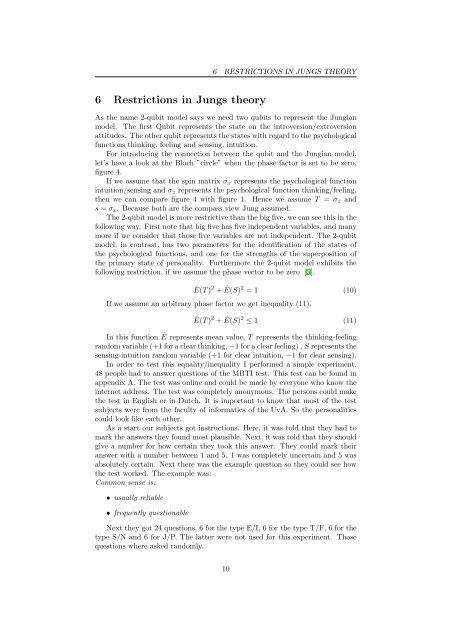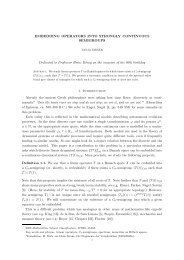Automatic modeling of personality types - Universiteit van Amsterdam
Automatic modeling of personality types - Universiteit van Amsterdam
Automatic modeling of personality types - Universiteit van Amsterdam
Create successful ePaper yourself
Turn your PDF publications into a flip-book with our unique Google optimized e-Paper software.
6 Restrictions in Jungs theory<br />
6 RESTRICTIONS IN JUNGS THEORY<br />
As the name 2-qubit model says we need two qubits to represent the Jungian<br />
model. The first Qubit represents the state on the introversion/extroversion<br />
attitudes. The other qubit represents the states with regard to the psychological<br />
functions thinking, feeling and sensing, intuition.<br />
For introducing the connection between the qubit and the Jungian model,<br />
let’s have a look at the Bloch ”circle” when the phase factor is set to be zero,<br />
figure 4.<br />
If we assume that the spin matrix σx represents the psychological function<br />
intuition/sensing and σz represents the psychological function thinking/feeling,<br />
then we can compare figure 4 with figure 1. Hence we assume T = σz and<br />
s = σx. Because both are the compass view Jung assumed.<br />
The 2-qubit model is more restrictive than the big five, we can see this in the<br />
following way. First note that big five has five independent variables, and many<br />
more if we consider that those five variables are not independent. The 2-qubit<br />
model, in contrast, has two parameters for the identification <strong>of</strong> the states <strong>of</strong><br />
the psychological functions, and one for the strengths <strong>of</strong> the superposition <strong>of</strong><br />
the primary state <strong>of</strong> <strong>personality</strong>. Furthermore the 2-qubit model exhibits the<br />
following restriction, if we assume the phase vector to be zero [5].<br />
Ê(T ) 2 + Ê(S)2 = 1 (10)<br />
If we assume an arbitrary phase factor we get inequality (11).<br />
Ê(T ) 2 + Ê(S)2 ≤ 1 (11)<br />
In this function Ê represents mean value, T represents the thinking-feeling<br />
random variable (+1 for a clear thinking, −1 for a clear feeling) , S represents the<br />
sensing-intuition random variable (+1 for clear intuition, −1 for clear sensing).<br />
In order to test this equality/inequality I performed a simple experiment.<br />
48 people had to answer questions <strong>of</strong> the MBTI test. This test can be found in<br />
appendix A. The test was online and could be made by everyone who know the<br />
internet address. The test was completely anonymous. The persons could make<br />
the test in English or in Dutch. It is important to know that most <strong>of</strong> the test<br />
subjects were from the faculty <strong>of</strong> informatics <strong>of</strong> the UvA. So the personalities<br />
could look like each other.<br />
As a start our subjects got instructions. Here, it was told that they had to<br />
mark the answers they found most plausible. Next, it was told that they should<br />
give a number for how certain they took this answer. They could mark their<br />
answer with a number between 1 and 5. 1 was completely uncertain and 5 was<br />
absolutely certain. Next there was the example question so they could see how<br />
the test worked. The example was:<br />
Common sense is:<br />
• usually reliable<br />
• frequently questionable<br />
Next they got 24 questions, 6 for the type E/I, 6 for the type T/F, 6 for the<br />
type S/N and 6 for J/P. The latter were not used for this experiment. Those<br />
questions where asked randomly.<br />
10

















